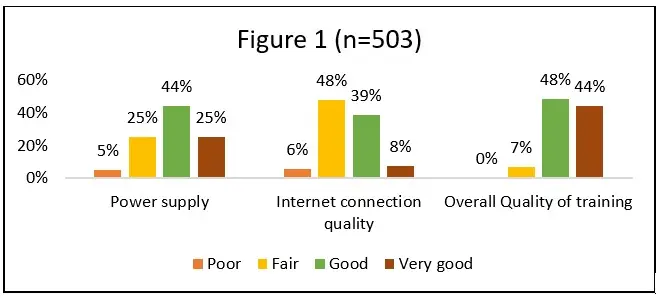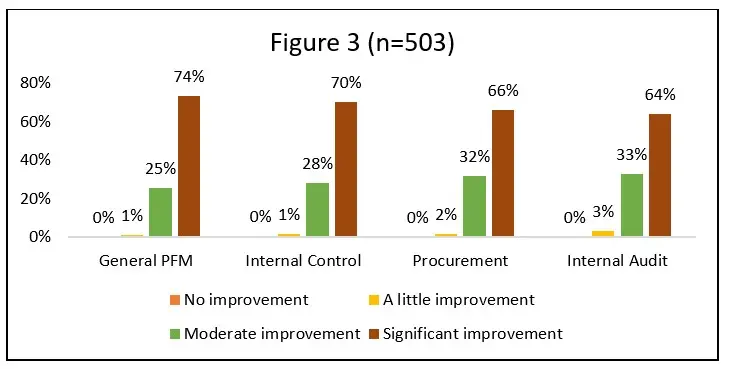Kara Reeve, RTI Urban Governance and Resilience Specialist, and Martin Phiri, RTI Governance Specialist, also contributed to this blog.
The COVID-19 pandemic has caused global disruptions and changed the way we live and work. Many adjustments have been required and the importance of good governance and transparency is even more crucial now. RTI made swift adjustments to the training and capacity building activities under the Accountable Governance for Improved Service Delivery (AGIS) project in Zambia to comply with social distancing and other government restrictions.
AGIS—funded by the U.S. Agency for International Development and led by Crown Agents—partners with the Ministry of Health (MOH) and the Ministry of General Education (MoGE) to increase transparency and accountability in the delivery of health and education services. As part of this program, RTI is working in close partnership with the MoH and MoGE to address capacity gaps in public financial management at the provincial and district levels, especially in the areas of internal controls, procurement, internal audit. AGIS works in Lusaka and Kafue districts in Lusaka Province, Chipata and Petauke districts in Eastern Province and Chinsali and Mafinga districts in Muchinga Province.
Prior to COVID-19 restrictions, the project team had designed and was delivering an in-person training series to build the capacity of government staff in procurement, internal controls, and internal audit. To comply with government regulations and social distancing requirements, the project quickly pivoted to a virtual training series using the Zoom platform. Our adaptations and learning are described in more details below.
Successful Virtual Trainings Have to Be Well Planned and Creatively Adapted
While there are concerns that moving trainings online would not have the same results as in-person training, our experience showed that, with careful and creative planning, they can be successful.
Our virtual training enabled a broader reach compared to in-person trainings and generated a high level of engagement. For the period of April to September 2020, over 600 people were trained in the three provinces, compared to 250 the project was targeting to train in person. There was also a high level of commitment from the facilitators drawn from the public and private sectors as well as support from top government officials such as Provincial Education Officers and District Education Board Secretaries in the MoGE and the Provincial Health Directors and District Directors of Health in the MoH.
We conducted a virtual pilot training in Lusaka with teachers (schools had been closed because of COVID-19) and MoGE administrative staff. The pilot training covered procurement, internal controls, and internal audit themes. The first session of the pilot was devoted to walking participants through how to use Zoom, answering questions, and troubleshooting with the aid of a Zoom Introduction Cheat Sheet that we developed. The feedback from participants during the pilot was used to inform future roll-out such as changing the length of the training to meet participant needs and understanding the right amount of data bundles that we needed to provide to participants to ensure optimal internet access during training.
We carefully considered how to enhance participants’ experience and how to effectively stimulate discussion as we adapted the training. Sessions were designed to be interactive, providing opportunities for questions and answers via chat. The breakout room feature in Zoom proved to be effective for small group discussions. We also developed online quizzes which were deployed at the end of the day’s training. Top performers in the quizzes were recognized and applauded the next day of training. The online quizzes helped stimulate and sustain engagement as well as reinforce learning.
Post-training Evaluation Results Show Promise of Moving Virtual
About 500 participants completed an evaluation at the end of the training. Our goal was to learn more about what worked well and where improvements could be made.
Infrastructure: About 52 percent of participants connected to the training with their smartphones while the rest connected with iPads, laptops, or desktop computers. We evaluated adequacy of power supply and sufficiency of data provided to participants using a scale ranging from poor, fair, good to very good. Sixty-nine percent of participants rated adequacy of power supply during trainings as good or very good, with 30 percent rating it as poor or fair. The relatively good ratings of power supply were not surprising given that participants connected to the training from their offices or schools where power is relatively more stable. The stability of Internet connectivity largely depends on the availability of power supply. About 48 percent of participants rated the quality of internet connection during training as fair while 46 percent rated it as good or very good. We learned that in addition to providing the right amount of data, it is important to also target quality by using the most reliable vendors for a particular area. (Figure 1).

Breakout sessions: We evaluated the Zoom-based breakout sessions for how well they stimulated discussion and engagement among participants. Using a 4-point Likert Scale (Strongly Disagree, Disagree, Agree, and Strongly Agree), over 85 percent of participants either agreed or strongly agreed that they communicated well during the session. Over 90 percent agreed or strongly agreed that they were able to effectively participate and provide ideas to discussions (Figure 2).

Knowledge improvement: Over 99 percent of participants indicated that their knowledge of public financial management moderately or significantly improved because of the training. For specific modules, more than 97 percent of participants indicated moderate or significant improvement in their knowledge of Internal Control, Internal Audit, and Procurement as shown in Figure 3.

Relevance and quality of training: About 96 percent of participants agreed or strongly agreed that the material taught was relevant to their needs (Figure 2). On a scale ranging from poor, fair, good to very good, more than 92 percent of participants rated the overall quality of the training as good or very good (Figure 1).
Next Steps
The Zambia AGIS project successfully pivoted from in-person to virtual training, strengthening the capacity of over 600 government workers in the Ministry of Health and General Education. Trainees’ enthusiastic and positive feedback in the post-training evaluation demonstrated the virtual can be as successful as in-person training with the added advantage of greater reach.
While infrastructural challenges can be particularly acute in these settings, they can be managed through targeted solutions like providing big screens in specific locations to allow for social distancing and for improved training delivery as well as providing data bundles from vendors known for quality. Since the main driver of overall quality of virtual training is likely to be the quality of internet connection, it is crucial to carefully test and provide data bundles from reliable vendors in each region.
As next steps, the project is setting up mentoring and coaching clusters in each province to help reinforce learnings from the trainings. The institutions have Technical working Groups (TWGs) in place made up of professional staff who oversee the respective thematic areas of the project focus. During mentoring and coaching sessions, which will be driven by project consultants, these members of TWG will be part and parcel of the mentoring process to ensure sustainability after the life of the project.
Virtual training holds promise for future capacity building in low- and middle-income countries even beyond the COVID-19 pandemic. Infrastructural challenges can be addressed innovatively, and project outcomes can be achieved despite unexpected disruptions.

